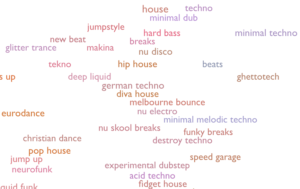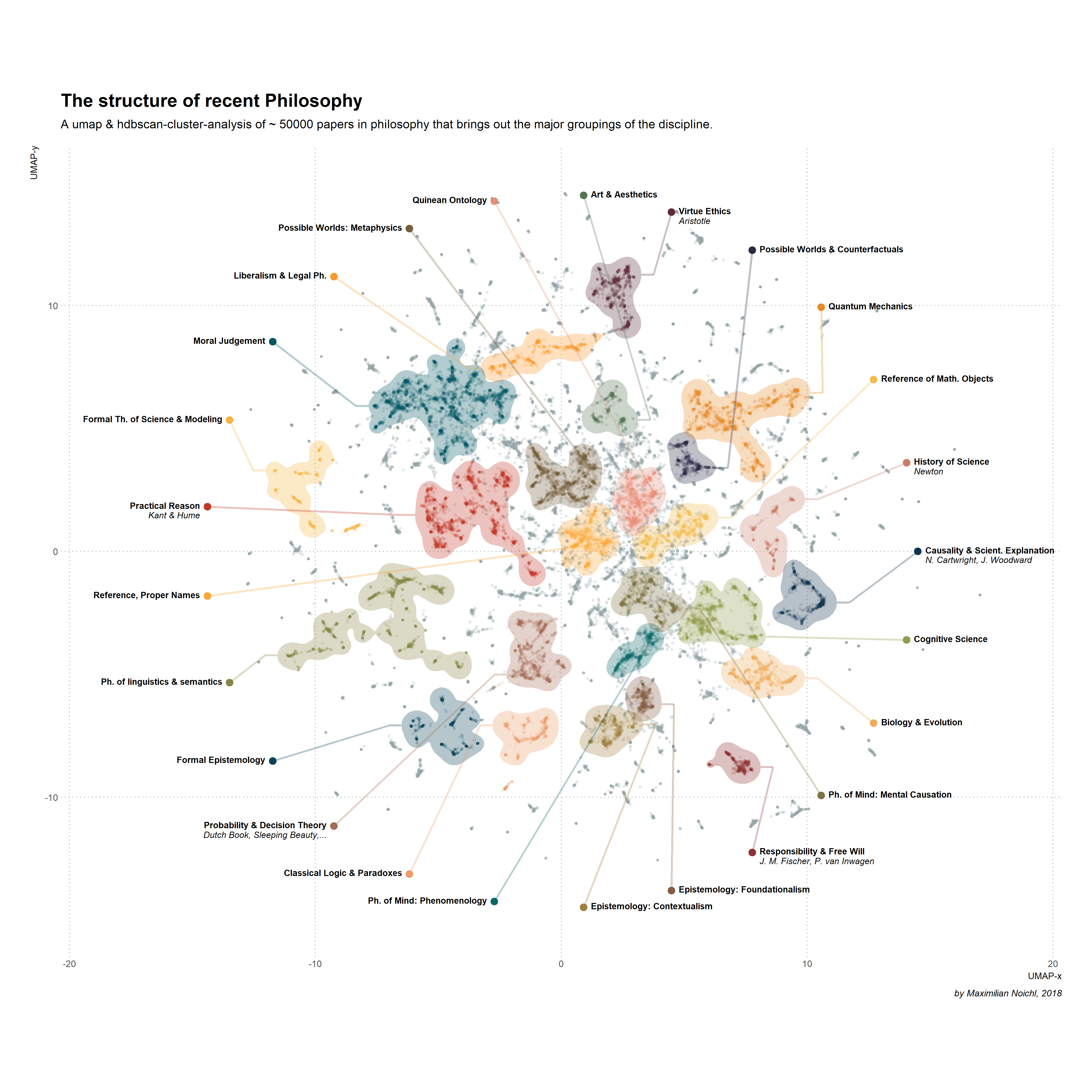Ted Underwood in a talk at the Novel Worlds conference talked about a fascinating project, Every Noise at Once. This project has tried to map the genres of music so you can explore these by clicking and listening. You should, in theory, be able to tell the difference between “german techno” and “diva house” by listening. (I’m not musically literate enough to.)
Nakamura: Transmedia Storytelling within the Media Mix system in Japanese Pop Culture
Today I had the honour to introduce Professor Aki Nakamura from Ritsumeikan University who talked about Transmedia Storytelling within the Media Mix system in Japanese Pop Culture at the JSAC 2018 conference in Edmonton.
He began by introducing us to transmedia storytelling. He talked about how transmedia franchises can extend the fictional world through space and time.
Continue reading Nakamura: Transmedia Storytelling within the Media Mix system in Japanese Pop Culture
Big Tech’s Half-Hearted Response To Fake News And Election Hacking
Despite big hand waves, Facebook, Google, and Twitter aren’t doing enough to stop misinformation.
From slashdot I found a story about : Big Tech’s Half-Hearted Response To Fake News And Election Hacking. This Fast Company story talks about ways that social media companies are trying to prevent the misuse of their platforms as we head into the US midterms.
For Facebook, Google, and Twitter the fight against fake news seems to be two-pronged: De-incentivize the targeted content and provide avenues to correct factual inaccuracies. These are both surface fixes, however, akin to putting caulk on the Grand Canyon.
And, despite grand hand waves, both approaches are reactive. They don’t aim at understanding how this problem became prevalent, or creating a method that attacks the systemic issue. Instead these advertising giants implement new mechanisms by which people can report one-off issues—and by which the platforms will be left playing cat-and-mouse games against fake news—all the while giving no real clear glimpse into their opaque ad platforms.
The problem is that these companies make too much money from ads and elections are a chance to get lots of ads, manipulative or not. For that matter, what political ad doesn’t try to manipulate viewers?
The slashdot story was actually about Mozilla’s Responsible Computer Science Challenge which will support initiatives to embedd ethics in computer science courses. Alas, the efficacy of ethics courses is questionable. Aristotle would say that if you don’t have the disposition to be ethical no amount of training would do any good. It just helps the unethical pretend to be ethical.
The structure of recent philosophy (II) · Visualizations
In this codebook we will investigate the macro-structure of philosophical literature. As a base for our investigation I have collected about fifty-thousand reco
Stéfan sent me a link to this interesting post, The structure of recent philosophy (II) · Visualizations. Maximilian Noichl has done a fascinating job using the Web of Science to develop a model of the field of Philosophy since the 1950s. In this post he describes his method and the resulting visualization of clusters (see above). In a later post (version III of the project) he gets a more nuanced visualization that seems more true to the breadth of what people do in philosophy. The version above is heavily weighted to anglo-american analytic philosophy while version III has more history of philosophy and continental philosophy.
Here is the final poster (PDF) for version III.
I can’t help wondering if his snowball approach doesn’t bias the results. What if one used full text of major journals?
Every time Ford and Kavanaugh dodged a question, in one chart
There was a striking difference in style — and substance.
Vox has a nice interactive visualization of Every time Ford and Kavanaugh dodged a question, in one chart. The two visualizations, one for Ford and one for Kavanaugh, show at a glance how the latter dodged a lot more questions. You can click on the sections which are marked as dodgy and see the full text. Nice clear use of visualization to tell a larger story and let the user explore.
Self-driving pods are slow, boring, and weird-looking — and that’s a good thing
Driverless pods, retirement communities, and grocery delivery
Autonomous vehicles are here! That’s the message from a panel on AI and Transportation I listened to at the International Symposium on Applications of Artificial Intelligence held here at the University of Alberta.
Waymo, the Google spin-off, is bringing autonomous taxis to Phoenix this fall. Other companies are developing shuttles and other types of pods that work, Self-driving pods are slow, boring, and weird-looking — and that’s a good thing. It seems to me that there hasn’t really been a discussion about what would benefit society. Companies will invest in where they see economic opportunity; but what should we as a society do with such technology? At the moment the technology seems to be used either in luxury cars to provide assistance to the driver or imagined to replace taxi and Uber drivers. What will happen to these drivers?
AI Weirdness
I just came across a neat site called AI Weirdness. The site describes all sorts of “weird” experiments in learning neural networks. Some examples:
- Cat names like Colzyy, Mumhan and Tygrar
- Paint colours like Boo Snow and Sudden Pine
- Course titles like Genies and Engineering and Language of Circus Processing
The site has a nice FAQ that describes her tools and how to learn how to do it.
Franken-algorithms: the deadly consequences of unpredictable code
The death of a woman hit by a self-driving car highlights an unfolding technological crisis, as code piled on code creates ‘a universe no one fully understands’
The Guardian has a good essay by Andrew Smith about Franken-algorithms: the deadly consequences of unpredictable code. The essay starts with the obvious problems of biased algorithms like those documented by Cathy O’Neil in Weapons of Math Destruction. It then goes further to talk about cases where algorithms are learning on the fly or are so complex that their behaviour becomes unpredictable. An example is high-frequency trading algorithms that trade on the stock market. These algorithmic traders try to outwit each other and learn which leads to unpredictable “flash crashes” when they go rogue.
The problem, he (George Dyson) tells me, is that we’re building systems that are beyond our intellectual means to control. We believe that if a system is deterministic (acting according to fixed rules, this being the definition of an algorithm) it is predictable – and that what is predictable can be controlled. Both assumptions turn out to be wrong.
The good news is that, according to one of the experts consulted this could lead to “a golden age for philosophy” as we try to sort out the ethics of these autonomous systems.
Replaying Japan 2018
The last few days I have been in Nottingham, land of Robin Hood, at Replaying Japan 2018 (PDF) conference in the National Videogame Arcade. You can see my conference notes on Replaying Japan 2018 here. The quality of the papers was excellent. The community is gelling and the research is getting more and more interesting. Some highlights:
- The theme was music and we had a number of excellent papers on Japanese game music. We now have a Replaying Japan journal, thanks to Ritsumeikan. I’m the English editor so stay tuned for a CFP.
- As per tradition, Keiji Amano and I gave a paper on pachinko. This time we talked about the line between gambling and gaming.
- The keynotes were fabulous. The first was Masaya Matsuura who developed PaRappa the Rapper and other music games. He reflected philosophically about music, play and sound. The second was David Wise who has composed music for games including Nintendo’s Donkey Kong Country series.
It struck a number of us that the community is becoming sufficiently developed that it may be time to form an association in order to properly involve people. Until now it has been loosely organized by a network of us. It may be time to formalize.
EaaSI | The Software Preservation Network
I just learned about a new project called EaaSI | The Software Preservation Network. Stanford will be one of the nodes. They are looking at how to provide emulation as a service. They are using technology from Freiburg called bwFLA Emulation as Service.
Emulation as a strategy for digital preservation is about to become an accepted technology for memory institutions as a method for coping a large variety of complex digital objects. Hence, the demand for ready-made and especially easy-to-use emulation services will grow. In order to provide user-friendly emulation services a scalable, distributed system model is required to be run on heterogeneous Grid or Cluster infrastructure.
The Emulation-as-a-Service architecture simplifies access to preserved digital assets allowing end users to interact with the original environments running on different emulators. Ready-made emulation components provide a flexible web service API allowing for development of individual and tailored digital preservation workflows.
Emulation is going to be important to game preservation. Already the Internet Archive is making games and other software available with emulation. There is also the MAME (Multiple Arcade Machine Emulator) project that is a community project that has traditionally allowed people to play older games right from the bit sequence off cartridges.





